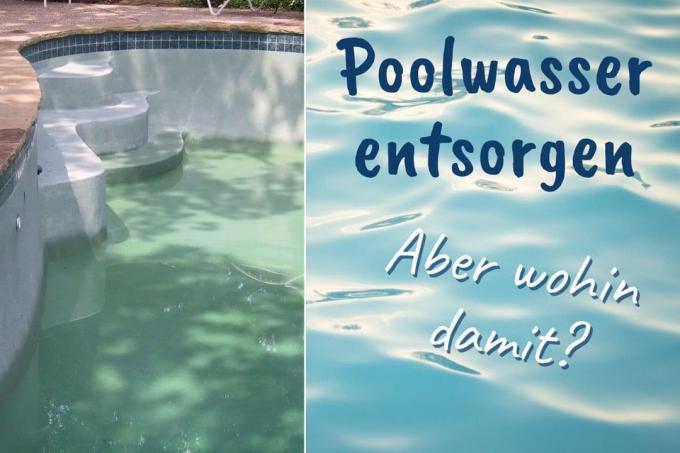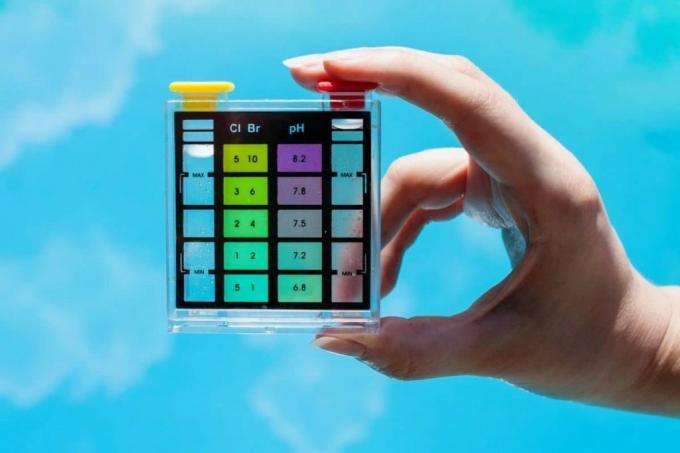
table of contents
- Environmental aspects
- Statutory Regulations
- Reduction of the chlorine content
- Empty the pool
- Sensible reuse
- frequently asked Questions
If the pool water has to be drained off at the end of the season, the question arises of what to do with the many liters, even with smaller quantities. Pool water must be properly prepared before disposal.
In a nutshell
- Chlorine levels must be reduced before disposing of pool water
- Water contaminated with algicide or biocide should be disposed of
- You can only let chemical-free water seep into the garden
- Water that does not contain any chemicals can be recycled
- Check with your local authority for information on the regulations governing the disposal of pool water
Environmental aspects
The water in a swimming pool is a mixture of different chemicals that ensure that No bacteria or other pathogens that can be dangerous for bathing people can form in it could. The water does not harm the skin and is also safe to take in small amounts orally.
The situation is different if you want to dispose of large amounts of pool water, because you are then releasing a chemical cocktail. This can certainly lead to health problems and become dangerous for the environment. If the pool water is disposed of without permission, it may react with other chemicals. Cleaning agents in particular, such as those found in wastewater, can lead to dangerous vapors.
Even if you simply leave out the pool water in the garden, it can have far-reaching consequences for the groundwater. The water can potentially contaminate wells, which would result in high renovation costs.
Tip: Before disposing of the pool water, check with your local authorities about the permitted disposal methods.

Statutory Regulations
Basically, it is forbidden to simply dispose of water that is contaminated with chlorine. This includes both discharging into a sewer and allowing it to seep into the garden. This does not apply to water with a chlorine content below the limit of 0.05 milligrams per liter of water.
In addition, the water must be in a range of neutral pH. A value between 5.5 and 7.4 is ideal. In addition, the water must not contain any other chemicals. These include, for example, biocides and agents to prevent algae.
Note: There may be regional differences in this limit value, as it is not regulated uniformly. However, many environmental authorities adhere to this value, but you should always ask beforehand.
The guide values always apply to the water in the pool and not to the amounts that have been added to the water. If chemicals are left over for the pool at the end of summer, they cannot simply be disposed of. This also applies to rinsing and cleaning water, which is used for the pump, for example. These agents are problematic substances that you have to hand in at collection points.
Reduction of the chlorine content
Since it is only allowed to dispose of the pool water when the chlorine content is below a certain guide value, this is the first task before you can drain the water.
To reduce the chlorine level, proceed as follows:
- Remove pool cover and use sunny days as possible
- no more chlorination for at least a week prior to the appointment to drain
- Remove chlorine residues in dosing systems
After a week, measure how high the chlorine content is in the water. If it is still above the limit value, wait a little longer, because the UV light supports the splitting of the chlorine, whereby the chlorine is broken down. If the water level is not at its maximum, you can top up with water if necessary. However, you should only do this if absolutely necessary to conserve water.

Empty the pool
If the water meets the legal requirements, you can dispose of it. Different methods are allowed. You can dispose of the water through the sewer or let it seep into the garden. In both cases, however, there are conditions. Some municipalities only allow a certain amount of water to be fed into the sewage system.
If you want to let the water seep into the garden, the following requirements apply:
- Soil must be unsealed
- Infiltration must be slow
- Water must not be contaminated with biocides or algicides
- The distance to buildings and streets must be sufficient to avoid substantial damage
Sensible reuse
It is environmentally friendly if you consider a sensible reuse for the pool water. The water can be used in a variety of ways, which also has the advantage that large amounts of water do not end up in the sewage system. Especially in autumn you can use the pool water for cleaning before you put your equipment in the winter.
Examples of re-use:
- Washing water (car, machines, garden chairs, tools)
- Service water (toilet flushing, cleaning water)
- Irrigation water (only possible with untreated water)
- Lawn irrigation
Reusing pool water is not only environmentally friendly, you can also save water costs. You can even divert the unpolluted pool water into water tanks as irrigation water. That can be done next spring or Early summer can be a valuable resource when there is no rainfall.

frequently asked Questions
You can bathe in it a few days after you stop adding chlorine to the water. However, the chlorine ensures that no germs and bacteria multiply in the standing water, a low chlorine content means an increased health risk when bathing.
Yes, if you have the option of fine filtering in a filter system, the chlorine content can also be reduced. However, the operation of the pump costs energy, which is not very environmentally friendly, which is why you should prefer methods that conserve resources. Only if you have to change the water quickly during the season because it changes after one Letting contamination no longer stabilize, consider using fast methods such as filtering to grab.
Yes, before you drain the water you have to check all values again. You may only dispose of the pool water when the water meets the standards.
When you dispose of the pool water, there should always be some residue left in the pool as this gives the pool stability. However, if repairs or cleaning are pending or if the water is tipped, you can dispose of all the pool water.
Where can I find out which limit values exist for pool water. - In addition to the local authorities, you can also find out more from the local water company. Municipalities also often publish information brochures that are available online as the number of private pools increases from year to year. If you have a small wastewater treatment plant, contact the company that installed the small wastewater treatment plant beforehand.

